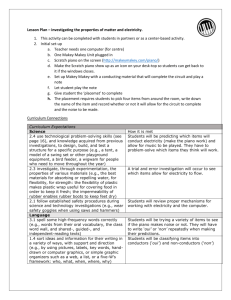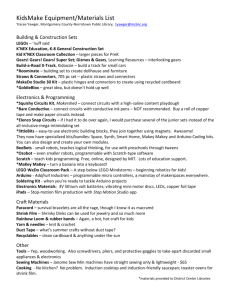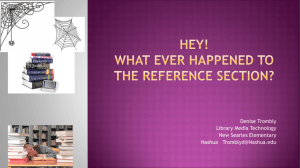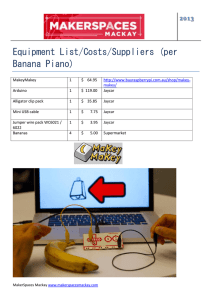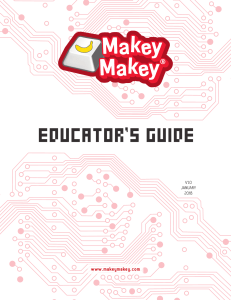Start Making!
advertisement
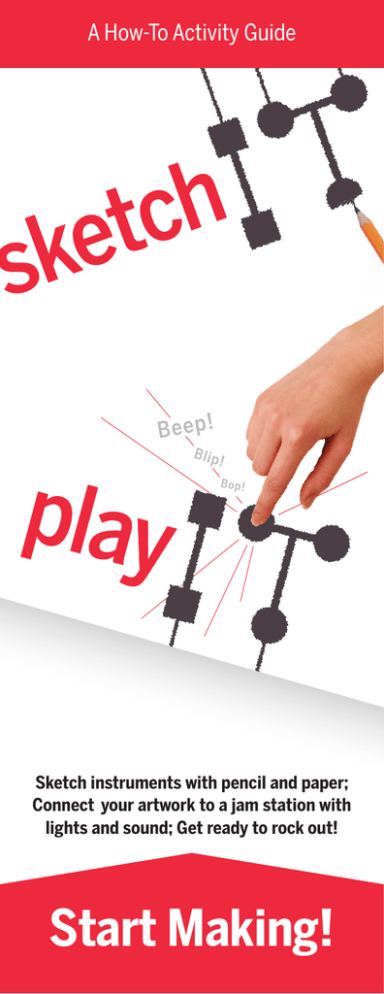
A How-To Activity Guide Sketch instruments with pencil and paper; Connect your artwork to a jam station with lights and sound; Get ready to rock out! Start Making! The Basics Sketch > Test > Play Before setting it up big, or if you want to try it with just a few friends/students/children, start here. You can always build it bigger after this part is done. Let’s get it going in 3 steps! Setup Time: 10–30 minutes Play Time: 10 minutes to 10 hours! Overview video (45 secs) at: http://start-making.org SKETCH IT! PLAY IT! at your School / Maker Space / Kitchen Table / Party / Community Festival Stuff You’ll Need: Laptop ...or other computer with speakers. MaKey MaKey Kit In this Guide: The Basics Sketch > Test > Play Clipboard(s) One per participant. A Little More Louder, Brighter, Scaling Up Further... Learning/Creative Possibilities Pencil(s) One per participant. Paper Plenty of sheets. By the Start Making! Initiative 1 Step 1 “Play It!” Station Set-Up First, setup your “Play It!” station where you can jam on your paper instruments. > Browse to: http://scratch.mit.edu/projects/ericr/2543877 or try Googling “makey scratch piano.” (You may need to install Flash or Javascript.) > Plug the MaKey MaKey in USB and connect alligator clips to the four arrow keys and space bar. Also connect one alligator clip to “Earth” for grounding people. Leave the alligator clips loose, hanging out so people can connect to them. Connect alligator clips to the four arrow keys and the space bar. Connect Makey Makey to USB port of computer. Connect one alligator clip to “Earth” for grounding people. > Click once on the piano to focus the computer’s attention on the piano. Leave the alligator clips loose, hanging out so people can connect to them. > Try pushing the arrow keys and space bar on your computer’s keyboard. You should hear the piano make sounds. 2 3 Step 2 Step 3 “Sketch It!” Station Set-Up Facilitate a Creative Session (or skip ahead to the next section and make it bigger and better!) Your “Play It!” station now makes sounds and is ready. Next, you want to setup a “Sketch It!” station so your participant creators can make these sounds without using the computer keyboard. They will draw their own instruments. Consider making at least one instrument yourself before getting started with the activity (or have everyone do it together). > Lay out one clipboard for each participant and some paper and pencils on the table next to the computer. > Look over these instructions for participating in the activity: 4 One good way to get started is to just jam out on your instrument that you’ve made at the “Play It!” station. I find that when everyone sees the results they may want to try it themselves—let them! After some playing it’s quite possible they will want to make one of their own. You have your “Sketch It!” station ready. Let people do it themselves for the most part, but some smaller people may not have the coordination to draw dark lines. In that case you can let them design the instrument, but you can make their lines darker. Troubleshooting: •Are the lines dark enough? •Do the lines cross over each other? Usually beginners are recommended to keep their lines separate so that each line makes one distinct sound. •Is the alligator clip touching the pencil drawing nicely? •Are somebody’s hands just too dry? Try putting out a damp sponge for people with dry hands. •Have you clicked on the piano to bring browser focus to the piano? •Is your sound turned on? Try pushing the arrow keys directly on your keyboard and watch the piano on the screen. •Is the MaKey MaKey plugged in USB? •Are you drawing on a smooth, hard surface (like a clipboard)? •Are you grounded? You have to be touching ground AND touching the arrow input both at the same time. 5 A Little More Step 2 Make It Light Up Louder, Brighter, Scaling Up If you want more people, and a bigger effect, this section is for you! Materials: Louder, Better Sound: Speakers, Soundplant files (downloaded) Brighter: Incandescent lights, power strip, Power Tail ii, small phillips-head screwdriver Scaling Up: Tables, pencil sharpeners, craft bins, facilitators and more of everything you already have. Step 1 Make It Louder and Sound Better ! Caution: this step involves high voltage AC power. Always use caution and set up with adult supervision. > Connect your Power Tail ii to the MaKey MaKey a) Put connector wires into the Keyboard Output terminal and Ground terminal on the back of the MaKey MaKey board. b) Run the Output wire to (+) and the Ground wire to (-) on the Powertail. c) Clamp down screw terminals with screwdriver. > Plug your power tail into the wall. > Plug your power strip into the power tail. Setup Time: 20 minutes > Plug your lights into the power strip. > Download Soundplant from here: soundplant.org/download.htm > Download sound files from here: Mac: start-making.org/sounds.zip Windows: start-making.org/winsounds.zip Now when you trigger the MaKey MaKey, the lights should turn on! > Install and open Soundplant; unzip the sound files. You can make your own sounds by dragging sound files (like .wav files) onto the keyboard GUI. Or you can just open the .keymap file from the sound folder you have unzipped. It should be premapped with sounds on the <UP> <DOWN> <LEFT> <RIGHT> <SPACE> <W> <A> <S> <D> <F> keys. Synthesizer sounds are on the arrows and space, and drum sounds on the letters. Try pushing keys on your keyboard and hear your new sounds. > Plug in louder speakers. You could try regular computer speakers, or you can hook to a larger amplifier like such as this: amazon.com/Fender-Passport-150-Portable-System/ dp/B0034PDQPY 6 Trouble Shooting: •Are the lights turned on? •Is the MaKey MaKey plugged into the USB port and getting power? •Are all the wires hooked up right and the screw terminals clamped down? •Did you accidentally hook up to the “Gnd” port on the Powertail instead of the (-) “minus” port? •Is there a switch on your powerstrip and is it turned “on” (often called “reset” instead of “on”)? 7 Step 3 Scaling Up: Prepare for 10, 100 or 1,000 people! Setup Time: 1 hour •One “Play It!” table for every group of six people. As soon as you get more than a few people you will want to have one station for sketching the instruments, and another station for playing music. If you are running this activity for an ongoing flow of people, consider how many people will be at your activity at any one time. Here is a rough rule of thumb for how much supplies you need to handle a certain number of people at one time: •One “Sketch It!” table (approximately 3’ x 6’ table with pencils, clipboards, sharpeners, paper, instruc tions) for every group of six people. 8 •One clipboard for each participant. •One or more pencils for each participant. •One pencil sharpener for each cluster of “Sketch It!” tables. •A Test station for each cluster of “Sketch It!” Tables. Put a mini “Play It!”station on the table with just one alligator clip coming out for sound and one ground/ earth alligator clip. This lets people test if their musical instrument drawing is working without getting up to go to the other station. 9 •One helpful facilitator for each “Sketch It!” cluster of tables and for each “Play It!” cluster of tables. Hint: Hang up example sketches to inspire and facilitate people in making their own. Use a clothes line and clothes pins, or tape them to a wall or foam core. Let people add their own if they don’t want to keep them when they leave. Consider: Put some other conductive and found materials in the back of the workshop so people can get creative beyond the paper if they are inspired to do so. •One set of instructions printed out at each cluster of “Sketch It!” tables. We usually assume people will stay on average for 20 minutes, some staying for only one minute, some staying for an hour. So if you want to entertain 100 people in two hours, then you should probably be ready to have 16 people at any one time. 10 11 Further... Learning/Creative Possibilities Aside from the formative learning qualities of curiosity and creative confidence, here are some traditional skills and knowledge areas that participant creators come into contact with: Learning Possibilities Traditional Science •Conductivity •Insulators •Completing a Circuit •Ground and High Voltage (DC) •Alligator Clips •Switches Design and Engineering •User Interface Design •Debugging •Basic Circuit Layout •Ergonomic/Human Factors Performing Arts •Musical Performance •Auditory Aesthetics •Audience Receptions •Social Context •Visual Aesthetics Creative Twist Suggestions Steal this activity! Take it in your own direction: •Instead of music output, have a game output -Pac-Man -Mario -Tetris -Etc. •Instead of pencil drawing input, let people use another medium: -Play-Doh -Water -Plants -Etc. •Let people dig deeper into the Arduino: -Reprogram MaKey MaKey keys -Write their own Arduino Program -Access the headers on the back of the board 12 Powered by Start Making!
